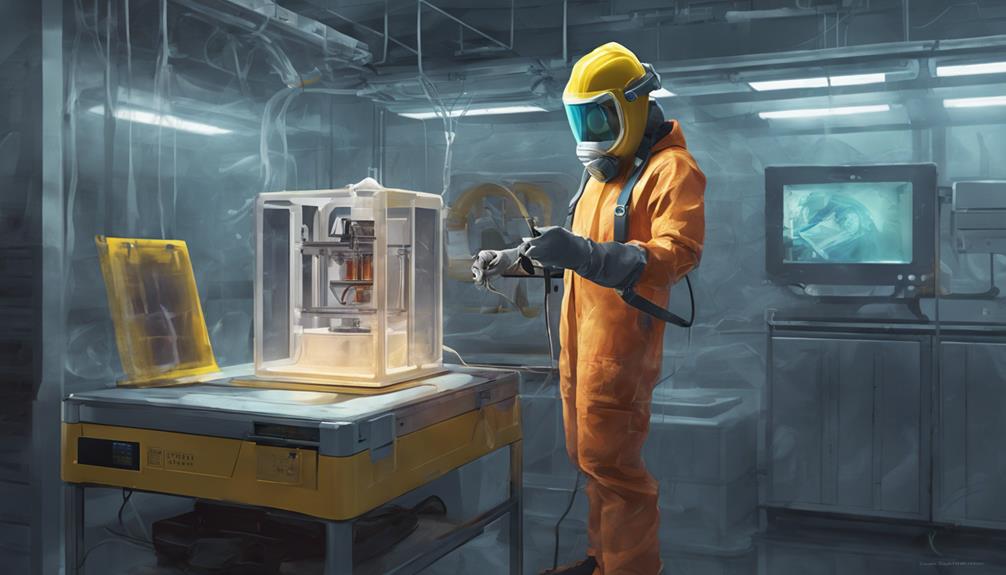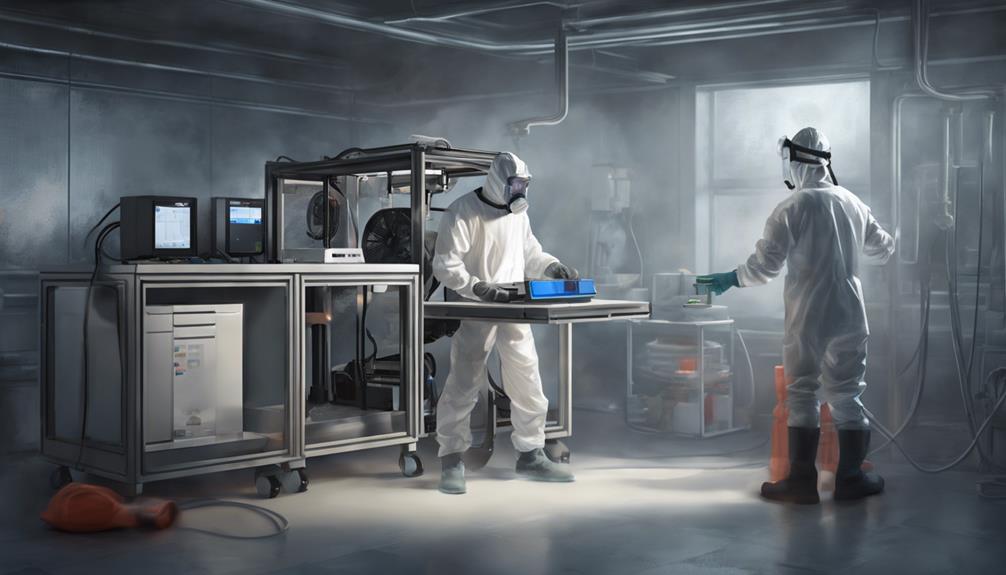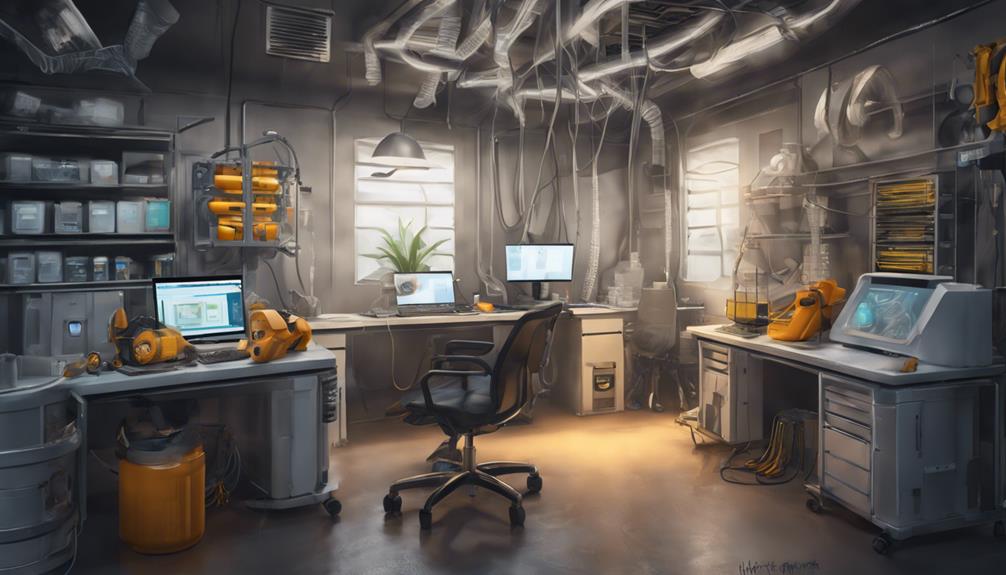As a 3D printing enthusiast, you may have noticed various odors while printing with different filaments. Understanding these scents is important for your safety. Identifying the distinct smells of PLA, ABS, and PETG can help you reduce potential risks. But what exactly do these odors signify, and how can you guarantee a safe printing environment? Stay tuned to uncover essential safety tips that will enhance your printing experience and protect your health.
Understanding 3D Printing Technologies

If you're new to the world of 3D printing, understanding the different technologies involved can help you navigate the process more effectively. Two main technologies you'll encounter are FDM and SLA.
FDM, or Fused Deposition Modeling, uses thermoplastics like PLA, ABS, PETG, and others to create objects layer by layer. On the other hand, SLA, or Stereolithography, utilizes liquid resin to produce detailed and heat-resistant items.
Each technology has its strengths and weaknesses, so choosing the right one for your needs is essential. FDM printers are cost-effective and great for simple designs, while SLA printers offer precise printing but at a higher cost.
Familiarizing yourself with these technologies will aid you in making informed decisions when venturing into the world of 3D printing.
Identifying Odors in 3D Printing
When 3D printing, identifying and distinguishing odors is essential for ensuring safety and understanding the materials being used. Different filaments and resins emit various odors when heated, some of which can be harmful if inhaled. Here is a table to help you recognize common odors in 3D printing:
| Odor Description | Possible Source |
|---|---|
| Sweet or sugary | PLA filament |
| Acrid or chemical | ABS filament |
| Strong and pungent | PETG filament |
Being able to identify these odors can alert you to potential safety hazards and guide you in choosing the appropriate safety measures for your 3D printing setup.
Ensuring Safety Measures in Printing

To guarantee safety in 3D printing, prioritize proper ventilation and protective gear when handling materials with strong odors or toxic compositions. Make sure your workspace is well-ventilated to minimize exposure to harmful fumes. Consider using a fume extractor or an air purifier to maintain air quality.
When working with resin printers, wear protective gear like gloves and a mask to reduce health risks. Always read the safety data sheets provided by filament and resin manufacturers to understand the potential hazards.
Implementing these safety measures will help safeguard your health and create a safer environment for 3D printing. Remember, taking precautions is essential to enjoy the benefits of this technology without compromising your well-being.
Comparing FDM and Resin Printers
Comparing FDM and resin printers reveals distinct advantages and considerations for users in the domain of 3D printing.
FDM printers are cost-effective for simple designs but emit odors during printing. They use thermoplastics like PLA and ABS.
On the other hand, resin printers produce harder, more detailed prints suitable for high temperatures. Resin printing involves using liquid resin that emits strong odors, often described as burnt plastic.
While FDM printers are more affordable, resin prints offer higher precision. Consider the type of projects you plan to undertake, your budget, and the environment where the printer will be located when choosing between FDM and resin printers.
Both options have their strengths and precautions to be aware of.
Tips From 3D Printing Enthusiast

For safer 3D printing practices, consider implementing tips from a seasoned enthusiast.
Start by ensuring proper ventilation in your workspace to reduce exposure to odors and potentially harmful fumes. Use an air purifier or set up a ventilation system to keep the air clean while printing.
Additionally, invest in quality filament and resin from reputable manufacturers to minimize toxic emissions. When working with resin printers, always wear appropriate protective gear like gloves and a mask to shield yourself from the harmful effects of resin fumes.
Regularly clean your printer to prevent the buildup of residue that can contribute to unpleasant smells. By following these tips, you can enjoy 3D printing while prioritizing your safety and well-being.
Frequently Asked Questions
How Can I Minimize Odors When Using a Resin 3D Printer?
To minimize odors when using a resin 3D printer, establish proper ventilation in your workspace. Consider using an enclosure and wearing protective gear. These precautions help reduce exposure to strong fumes emitted during resin printing, promoting a safer environment.
Are There Specific Health Risks Associated With Inhaling 3D Printing Fumes?
When inhaling 3D printing fumes, be cautious as different materials emit distinct odors and toxic gases. Ventilate your space well, wear protective gear, and choose safer filaments. Reduce health risks by taking necessary precautions.
What Steps Can Be Taken to Reduce Noise Pollution From a 3D Printer?
To cut noise from your 3D printer, position it on anti-vibration pads or in a soundproof enclosure. Guarantee regular maintenance for quiet operation. A tad of effort can turn your loud 3D printer into a purring kitten!
Can 3D Printing Materials Be Recycled or Disposed of Safely?
When recycling or disposing of 3D printing materials, practice safe methods. Recycle thermoplastics like PLA or properly dispose of resin to avoid environmental harm. Follow guidelines for recycling programs or hazardous waste facilities to protect nature and communities.
Is It Possible to 3D Print Food-Safe Objects Using FDM or Resin Printers?
When printing food-safe objects using FDM or resin printers, make sure you select materials approved for food contact. Resin printers may offer better heat resistance, but proper handling and precautions are essential due to toxicity concerns.
Conclusion
In summary, being mindful of the various odors in 3D printing is essential for your safety.
Just like a chef uses different spices to create a delicious meal, understanding and addressing these odors will guarantee a safe and healthy printing environment.
So remember to prioritize ventilation, protective gear, and safety measures to enjoy your hobby without any risks.
Happy printing!